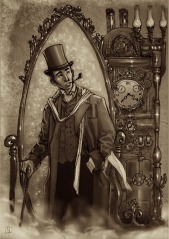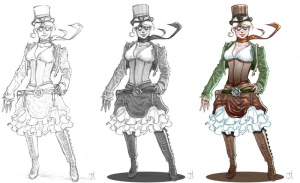Greetings, dear guest!
My exams are over since yesterday, so Steamagination will once again have regular updates. Today it’s time to finish Game of Shops.
Addicting addition
The last thing worth writing about in a Game of Shops is a major subplot that started as a joke and turned out to be really, really serious, probably more serious than anything else in the campaign. When a halfing scoundrel, Tomek Bugajło (Bugaylo) allied with the PCs they not only gave him promised shelter, but also tried the black lotus he was selling! At first they were very wary about using this drug, but soon they began to indulge in it.
And it was quite a surprise for me. Drugging themselves is something that positive characters certainly shouldn’t do and while nineteenth century knew less about addictions than our times the lotus is not just any drug, it’s the opium of Urda – and Urda probably already had its Opium wars. I must honestly admit that I haven’t read much about opium usage while I was running A Game of Shops but now I know that while it was used as a medicine in the nineteenth century selling it to people who didn’t really need it was a crime in victorian England. Even before I knew that it was clear to me that such an addiction must have some consequences, but I didn’t want to simply disallow using the lotus. It would be treating my players like children, something too similar to “sledgehammering” described in Drugs are bad at TvTropes.

There’s nothing wrong (period-wise) with a character smoking a pipe. Opium, however, is a more serious matter.
At first I’ve decided to demonstrate how inconvenient it is to smoke lotus. It looked like an innocent joke – every time somebody smoked lotus he rolled expression and his thoughts materialized with intensity based on the result of this roll. TN 15 gave a single picture while rolling 25 or more created something real and lasting.
The one who smoke the most was Zdzisław Nowicki (Zdhyswav Nowitsky), an ogre athlete always dreaming of battles with worthy opponents so his lotus dreams were various powerful boxers – trolls, ogres and so on. Sometimes a single test was enough to defeat them and make them vanish, but with good rolls they were so durable that Our Ladies and Gentlemen had to fight them for several rounds. Lots of things in their estate got demolished, but strangely they found it amusing rather than distracting and continued to smoke.
Amoral and shocking, isn’t it? But now as I think about this addiction it seems to me that the whole story became better because they didn’t stop. You know – drugs are such a danger because they are tempting. The PCs liked the “trips” they owed to the lotus so they indulged themselves with one drug-stuffed cigar after another and that allowed me to consider them real addicts and serve them a real nightmare trip. Courtesy of a sandbox-liking Game Master.
Black lotus is a fantasy drug[1], so getting addicted to it has very peculiar effect. It is strongly associated with writers who can’t tell the difference between their creations and the real world, so I’ve decided that the PCs who smoked lotus regularly – Zdzisław and Kevin, a sniper from Avalon – were losing their grip on reality. Zdzisław was haunted by a hallucinatory Szkudrycki (you know, the policeman who arrested him before) while Kevin, who at the moment of the first hallucination was spying in an inn like a Hooded Stranger from a fantasy setting met a group of three typical D&D heroes: a halfing thief, a dwarven warrior and an elfen mage. They asked him to give them a quest and later to protect them from a mysterious undead Warlock.
Both Kevin and Zdzisław were attacked by their hallucinations, but only Zdzisław resisted. It was a fun to hear him talking to Szkudrycki: I wasn’t guilty! You can’t arrest me! Wait, why am I talking to you? You don’t exist! Kevin, however, gave in. not only did he cooperate with his newfound friends, he also took later the side of the Warlock and began to believe the words of this wraith more than those of his existing companions.
Others tried to persuade him to turn back from this path leading nowhere, but when he decided to listen to their advices it was too late. When the campaign came to an end, a devil attacked Vidlice. The rest of Our Ladies and Gentlemen were fighting with him while Kevin hid himself with an artifact the devil was after, but then the Warlock approached him and persuaded our poor addict to enter his astral realm. A realm of ice and undeath, in fact created only to be an eternal prison for naïve Kevin. There was probably no higher-staked discussion in the entire history of my Wolsung sessions.
However, it wasn’t a va banque confrontation, so Kevin had a chance of escaping – Daphne Fatestring, a True Artist from a session long ago had a dream of his prison and drew a painting which was a gate to this remote astral realm. His friends managed to get him out of there, but the lesson was well-learned: now every time somebody mentions black lotus at the table the rest tells him to stop at once. I don’t want to boast myself but I think that it was such a good lesson because I’ve designed it not as a lesson, but simply as a logical consequence of PCs’ actions. I haven’t told even once something like “don’t do this” or “lotus is dangerous”, I’ve just allowed the players to do as they please and then I made them face the consequences.
But enough of my stories of myself! Next time we’ll look at Operation Wotan, the first Wolsung supplement released in Poland. And next week I’ll post here a three-part mini-campaign about a great expedition to the North Pole with lots of mysteries, villains and, of course, tentacles. For what good are arctic regions without a little bit of At the Mountains of Madness?
[1] I saw it in Baldur’s Gate II and in stories about Conan, so it may in fact be the most generic fantasy drug ever.



